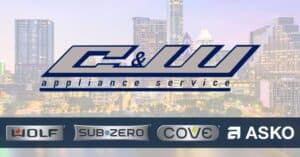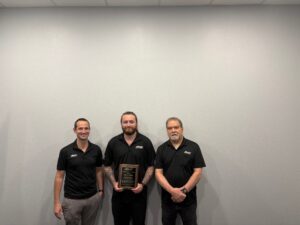
Many people are not aware of the vital role clothes dryer vents play in home safety.
Dryer venting systems are meant to safely carry lint (highly flammable particles of clothing) that gets past the lint filter. This is a very important function because, according to the National Fire Protection Association, there are more than 14,000 home fires every year involving clothes dryers. One of the leading causes of these fires is “dust, fibre, or lint”.
Equally importantly, dryer venting systems remove the hot, moist air and the carbon monoxide that is generated from combustion of natural gas.
A dryer venting system constructed from proper material, installed per code, and regularly cleaned, can prevent not only fires but also mold-related health problems and damage to interior woodwork caused by warm, humid air leaking from ductwork. Additionally, in the case of a gas dryer, it prevents carbon monoxide from leaking into your home.
Rules for Transition Ducts
In December 2006, Underwriters Laboratories introduced UL 2158A, “Clothes Dryer Transition Duct,” an approved standard for flexible, high-temperature transition ducts, rated to 430 °F., for both electric and gas dryers (this standard is also part of IRC M1502.4.3 and IMC 504.8.3)
Transition ducts are flexible duct sections that connect the back of the dryer to the exhaust duct system in the wall. Some homeowners are familiar with this silver tubing at the back of the dryer that looks like a giant slinky.
The requirements for transition ducts are as follows:
- Must be a single length — no connecting sections allowed.
- Can’t be concealed within construction, such as passing through floors, walls, hidden spaces, etc., or be longer than 8 feet.
- Only flexible ductwork listed, labeled, and in compliance with UL 2158A can be used.
As well, dryer manufacturers that allow foil ducts specify in their installation manuals and warranty requirements that foil-type flexible ducts must comply with UL 2158A.
Types of Transition Ducts
Foil flexible ducts are pliable and easy to install. You can find UL listed foil ducts in most hardware stores. However, some dryer manufacturers don’t allow them because they’re highly flammable. Their rough walls restrict air flow (the 4 inch opening collapses to 3.25 inches), and clog easily with lint. When the duct is kinked or crushed as the dryer vibrates against the wall over time (or is pushed), the air flow is restricted even further, building up heat and creating a potential fire hazard. If the dryer overheats and the lint catches fire, the foil duct won’t contain it.
White vinyl spiral ducts are still found in many homes, but are not UL approved for clothes dryer transition ducts. They’re very unsafe, burn more easily than foil ducts, and are prohibited by most building codes and appliance manufacturers. Using white vinyl transition ducts will void most dryer warranties.
Semi-rigid flexible aluminum ducts have a smoother interior for better air flow, collect less lint, and maintain their 4-inch opening. They’re harder to work with, however, because they crush easily, and are tough to bend in tight areas. They also don’t return to their original shape when squashed.
Dryer manufacturers prefer semi-rigid flexible ducts over foil, because the metal doesn’t burn unless the temperature reaches 482°F — a fire can be contained until it goes out. As well, metal ducts don’t sag with accumulation of moisture, water, or lint, which obstructs air flow. When buying a semi-rigid duct, make sure you get a UL listed one, as some are non-listed.
DryerFlex transition ducts are made from “multiple layers of 100 percent aluminum ribbon tightly wound over hot galvanized zinc coated wire” and, according to many home inspectors and dryer vent professionals, outperforms both foil and semi-rigid ducts. It is as flexible as foil, and easy to install, yet crush-resistant. With its smooth interior similar to semi-rigid ducts, DryerFlex also retains a 4-inch diameter, and doesn’t capture much lint. It has a UL 2158A listing, with the same fire safety level as semi-rigid aluminum, withstanding up to 482° without catching fire. If you want to use this for a transition duct, first check your dryer manufacturer’s manual to make sure it’s allowed.
Periscope or Slim ducts are rigid, aluminum ducts that telescope to extend their lengths (e.g. 24 to 45 inches), and can be installed horizontally, vertically, and diagonally. They have a wide rectangular shape, except for the two ends where they make 90-degree connections to the dryer and vent. Because many dryer manufacturers recommend only the semi-rigid or rigid metal transition ducts, a rigid aluminum periscope duct is a better solution if the space is tight between the dryer and the wall, and the dryer and wall vent are close together. You only need about 2-1/2 inches behind your dryer for these these types of duct. The very smooth interior of the periscope duct offers very little air resistance, which increases dryer efficiency and discourages lint buildup. The metal material also resists crushing and is a safer choice to prevent and contain fires.
Some periscope ducts fit only particular dryer models, so ensure you’re buying the correct one.
Dryer Ducts
Only rigid metal ducts, either aluminum or galvanized steel, are suitable for concealed dryer vent ducts that run inside floors, walls, and other areas before venting outside the home. Their smooth surfaces allow maximum air flow and resist lint accumulation, which contribute to fire safety.
Because rigid metal can’t be bent, elbow fittings are used to make 45- or 90-degree bends. Only aluminum foil duct tape should used for the connection fittings to prevent leaks and breaks. As well, no screws should be used to penetrate the ductwork — lint can accumulate on these screws, eventually creating a blockage and fire hazard.
Codes and Standards
In the United States, most home inspectors refer to the International Residential Code (IRC) M1502 for dryer venting. However, some states may have additional regulations.
The International Mechanical Code (IMC) 504 also includes extensive clothes dryer requirements. Texas has adopted both the International Residential Code and the International Mechanical Code (2015 editions).
According to the United States Consumer Product Safety Commission, there are also two voluntary sets of standards for dryer vent pipes:
- Underwriters Laboratories standard UL 2158, “Electric Clothes Dryers” for electric dryers.
- American National Standards Institute (ANSI) Z21.5.1/Canadian Standards Association (CSA) 7.1 standard, “Gas Clothes Dryers Volume I, Type I Clothes Dryers” for gas dryers.
Both the IRC and MRC codes defer to dryer manufacturers in determining vent lengths, diameters, and number of turns. Some manufacturer requirements are not as restrictive as these codes, and their vents run much longer.
For maintenance and repairs to your major appliances, you can trust the factory-trained and experienced technicians at C&W Appliance Service. Call us at (855) 358-1496 or use our online service request form for prompt, professional service.



